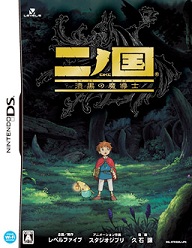Generation of Chaos
Playstation Portable
Reviewed: 04/30/2006
 Introducing a series to a new place can be a great thing. Doing so while not equipping the installment chosen to make the foreign debut with an informative manual or anything resembling an in-game tutorial about how these games work…generally isn’t great at all. So are the woes of Generation of Chaos, which can be an entertaining and engaging title, if the player can figure out what’s going on.
Introducing a series to a new place can be a great thing. Doing so while not equipping the installment chosen to make the foreign debut with an informative manual or anything resembling an in-game tutorial about how these games work…generally isn’t great at all. So are the woes of Generation of Chaos, which can be an entertaining and engaging title, if the player can figure out what’s going on.
Make no mistake, this is one incredibly deep and complex game. It takes a board game setup and uses elements from Civilizationlike sims, tactical RPGs, and military strategy games. A turn passes a month’s time in the game’s world, and will consist of moving generals, working the politics, shopping, perhaps some battles, and a number of other activities. Movement is done on a board game setup, with a large character moving around on set paths. Each person on the map is a general and represents a troop. Every single army and territory under the player’s control must be carefully watched and maintained, at the risk of losing them to an enemy or other negative consequences.
Similar to some PC strategy games, encountering an enemy general on the map will result in battle. In these, the player directly controls a general, who is in command of up to 30 allied combatants. The player also chooses things like formation and the plan of attack. One should pay attention to things like the weather and terrain conditions, as these can impact the fighting. After making the decision, the game battle begins, with AI controlling the regular soldiers. The player, as the general, can change strategies and give new commands on the fly; one can also take advantage of the general’s special attacks to give the allies a hand.
 |
| …And everybody’s looking for a partner. |
This fighting can be interesting, but sometimes frustrating as well. The AI of the regular soldiers leaves a lot to be desired. For example, the simplest of obstacles on the battlefield will prove mighty difficult for the army to get around. Much backtracking, attempted (and failed) turns, and comrades bumping into each other will occur within the player’s troop in every battle, without fail. And heaven forbid the player should want to take the commander to the front line to get within range; one’s own allies won’t get out of the damn way. Do the military academies here not teach the idea of obeying the general? The battles are decent overall, but they could have easily been better with some sharper AI and improved movement.
The story is set in a land of many traditional races, including humans, elves, undead, and others. It boils down to a pretty basic setup, with familiar concepts like “X number of warring kingdoms” and other RPG plot staples. The player will see the bulk of the tale from the perspective of the Dravanian Empire. What begins as innocent fending off attackers evolves into a quest to find a living sword which has the power to eliminate all who oppose Dravania. The outline is pretty stereotypical, but the player does get to drive the story’s course in big ways, though this review will not spoil the decisions the player will make.
The game is visually fine. The graphics are just what should be expected from an RPG of this nature, and players will notice some very nice artwork for the main characters. Sound is equally good, with decent music present and voice acting provided in both Japanese and English. The only drawback in the technical fields would be some occasional lag time when a character is starting a new sentence of dialogue. Be it at the very beginning of the conversation, middle, or end, switching characters or not, there is a chance of the game encountering unexplained slowdown during the simple act of talking. There is no rhyme, reason, or pattern to it. Luckily, it’s not a huge hindrance.
 |
| I thought this character was a dude at first. |
Idea Factory built Generation of Chaos under the assumption that its players would either have prior experience in the series, or have easy access to those earlier titles. Since the series had never seen daylight outside of Japan, this wasn’t an entirely illogical assumption, and it explains the lack on an in-game tutorial. North Americans who have not imported any prior installments are in huge trouble, however. The instruction guide that comes with GoC isn’t very informative, as it will tell players what certain in-game abbreviations mean, but not describe in detail what their function is, or why on earth the player would ever want to try them.
On the bright side, NISA noticed this flaw and did take some measure to prevent it by releasing a downloadable guide for the game. The fact that it equates to about 70 instruction book-sized pages of reading should say something about just how deeply things needed explained. Unlike most standard RPGs, and even many TRPGs, Generation of Chaos is freaking hard to figure out with trail and error alone, and one can’t just pick up and play relying on lessons learned in experience with other games. Using this guide helps the player make more sense of Generation of Chaos, and can make the game tremendously more enjoyable.
Generation of Chaos is largely what the player makes of it. On one hand, it can be seen as an overly complex game that takes entirely too much trial and error to learn. On the other, for those who take the time to really delve into the guide and learn the ins and outs of the game, it can be a very worthwhile and interesting strategy RPG. Few other games place their ultimate value in the hands of the player as much as Generation of Chaos.
-Heath Hindman
| Score Breakdown | ||
| Overall Average Out of 10 See our Review Criteria |
Gameplay | Average |
| Story | Average | |
| Graphics | Great | |
| Sound/Music | Very Good | |
| Replay Value | Average | |
| The Verdict: 5 | ||








